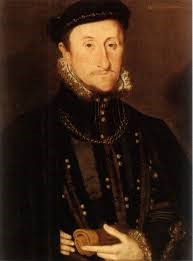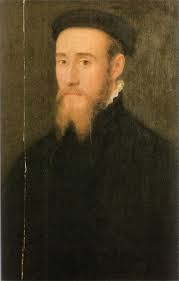Marie of Guise: Life Story
Chapter 10 : Rebellion (1557 - 1560)
Despite the marriage between Mary, Queen of Scots and the Dauphin having been planned since 1548, there was a group of Scots nobles who, by the end of December 1557, no longer wanted it to take place. The Earls of Argyll, Glencairn and Morton, with other lords signed a ‘Covenant’ to bring Scotland to Protestantism. They, together with Lord James Stewart (James V’s illegitimate son) invited John Knox to return from Geneva, although they then seem to have thought better of it – he received a letter when he was about to embark at Normandy, withdrawing the invitation. Knox saw their ‘inconstancy’ as an affront to God, and set sail anyway.

Up until this point there had been a tacit acceptance of private Protestant preaching and some services being held in Scots.However, this was not enough for the radicals. Marie, temperamentally inclined to tolerance, strove to preserve a balance between the Reformers and the Catholics but this became harder as the battle lines between Catholics and Huguenots became increasingly demarcated in France, and a new Protestant regime was in place in England. Forced to choose, Marie issued orders for the proper Catholic observance of Easter 1559 and for all Scots to return to the old faith.
John Knox’s return made compromise impossible. Knox was undoubtedly a hugely talented and charismatic preacher and writer, and although his style of preaching fire and brimstone, seems excessive to modern readers, he was soon winning converts both at Court and elsewhere. His brand of Biblical fundamentalism led him to believe, and preach, that for women to ‘bear rule’ was an ‘abomination’ and an affront to God.He shared these views in his ‘First Blast of the Trumpet against the Monstruous Regiment of Women’, published in 1558 in Geneva, which inveighed in most intemperate language against both Marie and Mary of England.
On 11th May, 1559, in direct contravention of the law, Knox preached at Perth. His sermon was so inflammatory that a member of the congregation threw a stone at a priest, and whole-scale rioting followed. Such disobedience could not be tolerated and Marie headed for Perth with troops to restore order. The Lords of the Congregation, however, supported Knox, and faced with a larger force, Marie retreated to Dunbar.
The Lords advanced on Edinburgh, arriving early in the morning of 30th June 1559. Their plan, according to Kirkcaldy of Grange, a Protestant chronicler, was to ‘maintain true religion, and resist the King of France.’
The people of Edinburgh were not notably enthusiastic at the arrival of the Lords, and in July Marie was able to drive them out and begin fortifying Leith. Of necessity, she called on French troops and their brutal behaviour alienated the Scots further.
On 21 October 1559 the Act of Suspension passed by the Lords of the Congregation to remove Marie from the Regency because, according to Knox, of her
‘Interprysed destruction of thair said commounweall-and overthrow of the libertie of thair native countrie.’
Marie maintained that the rebellion was against lawful authority and was not religiously motivated. The Protestants, however, did not necessarily see it the same way and they requested help from England, newly Protestant with the accession of Elizabeth I, against Catholic domination in the same way that, nearly twenty years earlier they had requested French help against English domination.
In November 1559, the Lords of the Congregation wrote instructions to William Maitland of Lethington to carry messages to Elizabeth. He was to inform her of the ‘cruelty and tyranny of the French captains and soldiers’ and the indifference of Marie to their ‘frequent complaints’ and her obvious desire to conquer Scotland for France.

He was also to draw attention to the risk to Elizabeth herself of the marriage between Mary and Francois and their provocation of the English monarch by promoting Queen Mary’s claim to the English throne. In support of the claim they had had a seal made quartering their arms with those of England and had sent Marie a ‘staffe for hir to rest upon, having graven in the toppe the said usurped armes’.
Lethington was then to ‘beseech’ Elizabeth to ‘afford them her gracious protection against the French intended conquest. Such a step, they continued, would allow Elizabeth to please the Almighty and procure ‘perpetual love’ between England and Scotland, which love was, apparently, a thing ‘much desired of all Christians, saving the French only’.
Elizabeth hesitated. She was extremely reluctant to get involved. Although events did not always allow her free reign in her decisions, her preference was nearly always to put solidarity amongst monarchs and obedience to lawful authority above religious differences. Eventually, she was persuaded – her chief minister, William Cecil was a determined Protestant and urged the importance of defending the Lords strongly. On 26th January, 1560, English ships arrived at Leith, and, following the February Treaty of Berwick with England, English troops arrived and by March were besieging Edinburgh Castle, with Marie in inside.
In the midst of this turmoil, Marie’s health broke down completely. She referred to her ailment as ‘dropsy’, and it was probably some sort of congestive heart failure that caused her to retain water. By 1st June 1560 she could neither eat nor lie down, and knowing the end was near, she sent for Moray and Arran. After begging their forgiveness for any wrong she might have done them, she died on 11th June 1560 at Edinburgh Castle with them at her side.
Her remains were embalmed and left in the Chapel of St Margaret within the Castle precincts. The Protestant Lords refused to allow a burial in Holyrood Abbey by the Catholic rites.Eventually, in March 1561, her body was taken at night and embarked at Leith for France.She was buried at the Convent of St Pierre Les Dames, where her sister, Renee, was abbess. Her monument was destroyed during the French Revolution.
Summary
Marie was in many ways a successful regent. She was clever, diplomatic and shrewd, and she achieved her immediate aims of preserving her daughter’s person and crown. She was described as ‘a woman with a man’s courage.’ Nevertheless, Marie did not see, or if she saw, did not accept, that times were changing. Her ambitions, as a member of a family that strove to dominate Europe, were essentially dynastic, built on the mediaeval concept of a country as the personal fiefdoms of its rulers. A move towards a more nationalist concept was growing, reinforced by the increasing rhetoric of religion as a defining characteristic of a country. The perception of Marie as the tool of a foreign state whose religion had been rejected by a large proportion of the ruling class condemned her to ultimate failure.
This article is part of a Profile on Marie of Guise available for Kindle, for purchase from Amazon.
Marie of Guise
Family Tree




